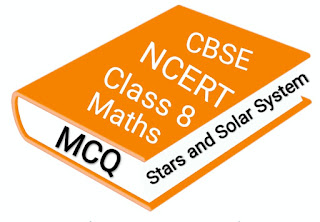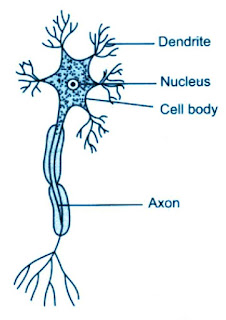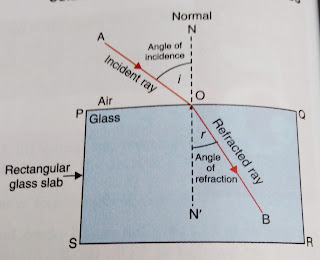Stars and the Solar System Class 8 MCQs Questions with Answers
MCQ Questions for Class 8 Science Chapter 15 Stars and Solar System Stars and the Solar System Class 8 MCQs Questions with Answers
-------------------------------------------------------------
Board CBSE
-------------------------------------------------------------
TextBook NCERT
-------------------------------------------------------
CLASS Class 8
--------------------------------------------------------
SUBJECT Science
----------------------------------------------------------
CHAPTER Chapter 17
-------------------------------------------------------------
SUBJECT Stars and the Solar System
--------------------------------------------------------------
Topic Multiple Choice Questions
---------------------------------------------------------
You May Also Like Multiple Choice Questions on -
Also Visit: 1.MCQ Class 8 Science
3. NCERT Solutions Class 8 Maths
Stars and the Solar System Class 8 MCQs Questions with Answers
Question 1.
Name the brighter planet in solar system
(a) Mercury
(b) Venus
(c) Saturn
(d) Earth
Answer
Answer 1:
(b) Venus
Venus is the brighter planet in solar system
Question 2.
Name the nearest planet from the sun
(a) Earth
(b) Venus
(c) Mercury
(d) Jupiter
Answer
Answer 2:
(c) Mercury
Mercury is the nearest planet from the sun
Question 3.
Name the planet in the solar system where life exist is
(a) Venus
(b) Mercury
(c) Earth
(d) Mars
Answer
Answer 3:
(c) Earth
Earth is the only planet in the solar system where life is exist.
Question 4.
Name the planet in the solar system which is appears to yellowish in colour.
(a) Earth
(b) Jupiter
(c) Uranus
(d) Saturn
Answer
Answer 4:
(d) Saturn
Saturn is the planet in the solar system which is appears to yellowish in colour
Question 5.
Which of the following does not belong to the family of solar system?
(a) Earth
(b) comet
(c) asteroid
(d) galaxy
Answer
Answer 5:
(d) galaxy
Galaxy does not belong to the family of the solar system.
Question 6.
After every…………… years Halley’s Comet is seen.
(a) 72
(b) 73
(c) 75
(d) 76
Answer
Answer 6:
(d) 76
After every 76 years Halley’s Comet is seen.
Question 7.
The galaxy in which our solar system is situated is
(a) Akash Ganga
(b) Milky Way
(c) Ursa Major
(d) Orion
Answer
Answer 7:
(b) Milky Way
In Milky Way galaxy our solar system is situated
Question 8.
In our solar system the hottest planet is
(a) Uranus
(b) Jupiter
(c) Earth
(d) Venus
Answer
Answer 8:
(d) Venus
In our solar system the hottest planet is Venus
Question 9.
Among the following, which is an inner planet?
(a) Jupiter
(b) Saturn
(c) Earth
(d) Neptune
Answer
Answer 9:
(c) Earth
Mercury, Venus, Earth, Mars are the inner planet.
Question 10.
Among the following, which is an outer parent?
(a) Earth
(b) Jupiter
(c) Mars
(d) Mercury
Answer
Answer 10:
(b) Jupiter
Jupiter, Saturn, Uranus, Neptune are outer planets.
Stars and the Solar System Class 8 MCQs Questions with Answers
Question 11.
Shooting stars are
(a) planets
(b) comets
(c) meteors
(d) stars
Answer
Answer 11:
(c) meteriors
Shooting stars are meteors
Question 12.
Name the furthest planet in our solar system is
(a) Jupiter
(b) Saturn
(c) Uranus
(d) Neptune
Answer
Answer 12:
(d) Neptune
Neptune is the furthest planet in our solar system.
Question 13.
The largest planet in our solar system is
(a) Mars
(b) Jupiter
(c) Saturn
(d) Neptune
Answer
Answer 13:
(b) Jupiter
The largest planet in our solar system is Jupiter
Question 14.
Stars appear to move from
(a) North to south
(b) South to west
(c) East to west
(d) West to east
Answer
Answer 14:
(c) East to west
Stars appear to move from East to west
Question 15.
Ursa Major is a
(a) constellation
(b) satellite
(c) comet
(d) planet
Answer
Answer 15:
(a) constellation
Ursa Major is a constellation
Question 16.
Which heavenly body is known by the name "morning star" or "evening star" ?
(a) pole star
(b) Jupiter
(c) Venus
(d) Saturn
Answer
Answer 16:
(c) Venus
Venus is known by the name "morning star" or "evening star".
Question 17.
Sun appears to move from east to west around the earth. This means that earth rotates from
(a) west to north
(b) north to south
(c) west to east
(d) east to west
Answer
Answer 17:
(c) west to east
Sun appears to move from east to west around the earth. This means that earth rotates from west to east
Question 18.
Which planet has the largest number of satellites?
(a) Jupiter
(b) Saturn
(c) Mars
(d) Uranus
Answer
Answer 18:
(b) Saturn
Saturn has the largest number of satellites.
Question 19.
Name the largest natural satellite in our solar system.
(a) moon
(b) eros
(c) ganymede
(d) lo
Answer
Answer 19:
(c) ganymede
The largest natural satellite in our solar system is ganymede
Question 20.
Star appears very small because
(a) they are very far away from earth
(b) actually they are small in size
(c) they have dim light
(d) none of the above
Answer
Answer 20:
(a) they are very far away from earth
Star appears very small because they are very far away from earth
Stars and the Solar System Class 8 MCQs Questions with Answers
Question 21.
The path around the sun on which the planets are move called
(a) orbit
(b) rotation
(c) revolution
(d) spin
Answer
Answer 21:
(a) orbit
The path around the sun on which the planets are move called orbit
Question 22.
1 light year is equal to
(a) distance covered by light in one day
(b) distance covered by light in one week
(c) distance covered by light in one month
(d) distance covered by light in one year
1 light year is equal to distance covered by light in one year
Answer
Answer 22:
(d) distance covered by light in one year
Question 23.
Different shapes of the moon are called
(a) parts of moon
(b) phases of moon
(c) rings of moon
(d) none of the above
Answer
Answer 23:
(b) phases of moon
Different shapes of the moon are called phases of moon
Question 24.
Name the planet which is closest to the sun.
(a) Mercury
(b) Venus
(c) Earth
(d) Mars
Answer
Answer 24:
(a) Mercury
Mercury is the closest planet from the sun.
Question 25.
Name the smallest planet in our solar system
(a) Jupiter
(b) Uranus
(c) Mercury
(d) Earth
Answer
Answer 25:
(c) Mercury
Mercury is the smallest planet in our solar system
Question 26.
The number of satellite the earth has
(a) one
(b) two
(c) three
(d) four
Answer
Answer 26:
(a) one
The earth has one satellite.
Question 27.
The brightest star in the night sky is
(a) Serius
(b) Vega
(c) Alpha Centauri
(d) Proxima Centauri
Answer
Answer 27:
(a) Serius
The brightest star in the night sky is Serius
Question 28.
To measure the distance between two heavenly bodies we use
(a) leap year
(b) light year
(c) century
(d) sound year
Answer
Answer 28:
(b) light year
To measure the distance between two heavenly bodies we use light year
Question 29.
The star which is nearest to earth is
(a) Serius
(b) Sun
(c) Pole Star
(d) Orion
Answer
Answer 29:
(b) Sun
The star which is nearest to earth is Sun
Question 30.
The heavenly bodies which are present between Mars and Jupiter are called
(a) comet
(b) planet
(c) meteors
(d) asteroids
Answer
Answer 30:
(d) asteroids
The heavenly bodies which are present between Mars and Jupiter are called asteroids
Question 31.
Which is not a planet?
(a) Jupiter
(b) Uranus
(c) Neptune
(d) Orion
Answer
Answer 31:
(d) Orion
Orion is not a planet.
Question 32.
The least dense planet is
(a) Earth
(b) Jupiter
(c) Saturn
(d) Neptune
Answer
Answer 32:
(c) Saturn
The least dense planet is Saturn
Question 33.
The first Indian satellite is
(a) INSAT
(b) EDUSAT
(c) Aryabhatta
(d) IRS
Answer
Answer 33:
(c) Aryabhatta
The first Indian satellite is Aryabhatta
Question 34.
The day on which the whole disc of the moon is visible is known as the
(a) Full moon day
(b) Lunar eclipse
(c) Solar eclipse
(d) No moon day
Answer
Answer 34:
(a) Full moon day
The day on which the whole disc of the moon is visible is known as the full moon day
Question 35.
The stars forming a group that has a recognisable shape is called
(a) Constellation
(b) Orion
(c) Lightyear
(d) Polestar
Answer
Answer 35:
(a) Constellation
The stars forming a group that has a recognisable shape is called constellation.
Stars and the Solar System Class 8 MCQs Questions with Answers
Fill in the blanks with the appropriate words:
Question 1.
………………. are the heavenly bodies which continuously produce heat and light.
Answer
Answer 1:
Stars are the heavenly bodies which continuously produce heat and light.
Question 2.
The last planet of our solar system is …………….
Answer
Answer 2:
The last planet of our solar system is Neptune.
Question 3.
The group of stars that appears to form a pattern in the sky is called……………
Answer
Answer 3:
The group of stars that appears to form a pattern in the sky is called a constellation.
Question 4.
The heavenly bodies which revolve around the sun are called……………..
Answer
Answer 4:
The heavenly bodies which revolve around the sun are called planets.
Question 5.
The heavenly bodies which revolve around the planet are called…………….
Answer
Answer 5:
The heavenly bodies which revolve around the planet are called satellites.
Question 6.
In between……………. and……………. we found heavenly bodies called asteroids.
Answer
Answer 6:
In between Mars and Jupiter we found heavenly bodies called asteroids.
Question 7.
Orion is seen during…………… season.
Answer
Answer 7:
Orion is seen during winter season
Question 8.
Halley's comet seen after…………… years.
Answer
Answer 8:
Halley's comet seen after 76 years
Question 9.
…………… constellation looks like a hunter.
Answer
Answer 9:
Orion constellation looks like a hunter.
Question 10.
Moon is a………………. satellite.
Answer
Answer 10:
Moon is a natural satellite.
Question 11.
The circular path around which planets are moved around the sun is called……………
Answer
Answer 11:
The circular path around which planets are moved around the sun is called orbit.
Question 12.
…………… is the largest planet in our solar system.
Answer
Answer 12:
Jupiter is the largest planet in our solar system.
Question 13.
…………… is the closest planet from the sun.
Answer
Answer 13:
Mercury is the closest planet from the sun.
Question 14.
The different shapes of the moon are called……………….
Answer
Answer 14:
The different shapes of the moon are called phases of the moon.
Question 15.
Inner planets are………………. , …………. , ……………. and……………
Answer
Answer 15:
Inner planets are Mercury, Venus, Earth and Mars.
Question 16.
The outer planets are……… , ………… , ………….. and …………….
Answer
Answer 16:
The outer planets are Jupiter, Saturn, Uranus and Neptune.
Stars and the Solar System Class 8 MCQs Questions with Answers
State whether the statements given below are True or False:
Question 1.
Sun is a planet.
Answer
Answer 1:
False
Sun is a star.
Question 2.
Mercury has no satellite.
Answer
Answer 2:
True
Question 3.
Saturn is the largest planet.
Answer
Answer 3:
False
Jupiter is the largest planet.
Question 4.
In our solar system, all planets rotate from West to East.
Answer
Answer 4:
False
Question 5.
Mars is called the blue planet.
Answer
Answer 5:
False
Mars is called the red planet.
Question 6.
The smallest planet of our solar system is Mercury.
Answer
Answer 6:
True
Question 7.
Moon is an example of a natural satellite.
Answer
Answer 7:
True
Question 8.
INSAT is an example of an artificial satellite.
Answer
Answer 8:
True.
Question 9.
Density of Saturn is largest among the all planets in our solar system.
(a)
(b)
(c)
(d)
Answer
Answer 9:
False
Density of Saturn is least among the all planets in our solar system.
Question 10.
One complete motion around the sun by a planet is called rotation.
Answer
Answer 10:
False
One complete motion around the sun by a planet is called revolution.
Match the following items given in Column A with that in Column
Question.
Answer
Answer:
Stars and the Solar System Class 8 MCQs Questions with Answers


